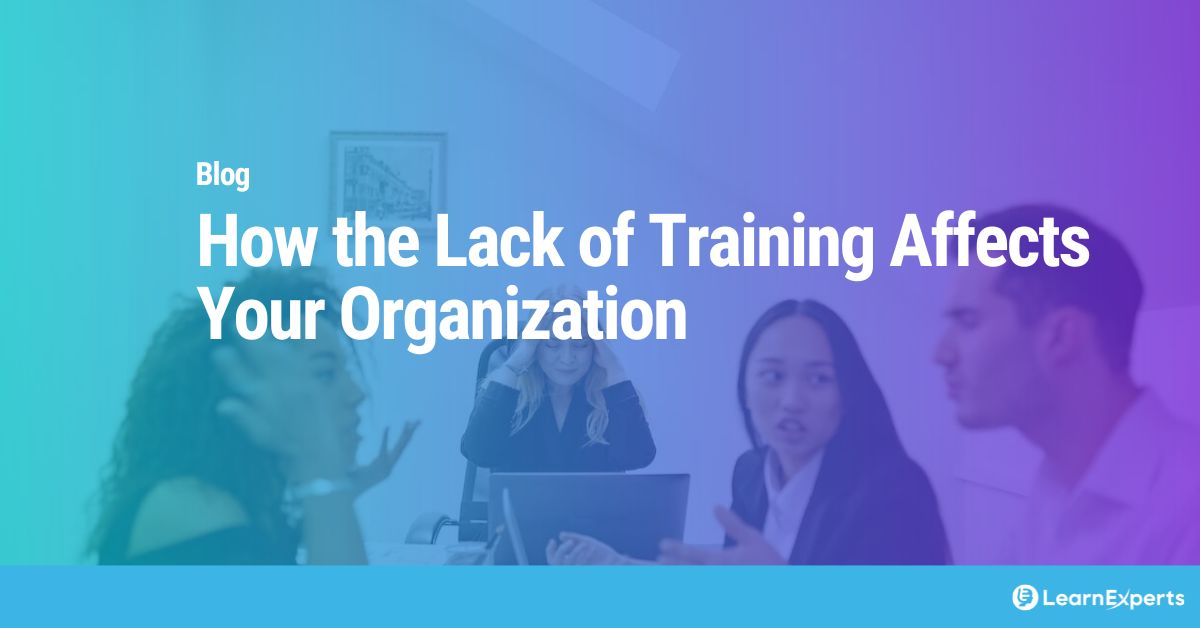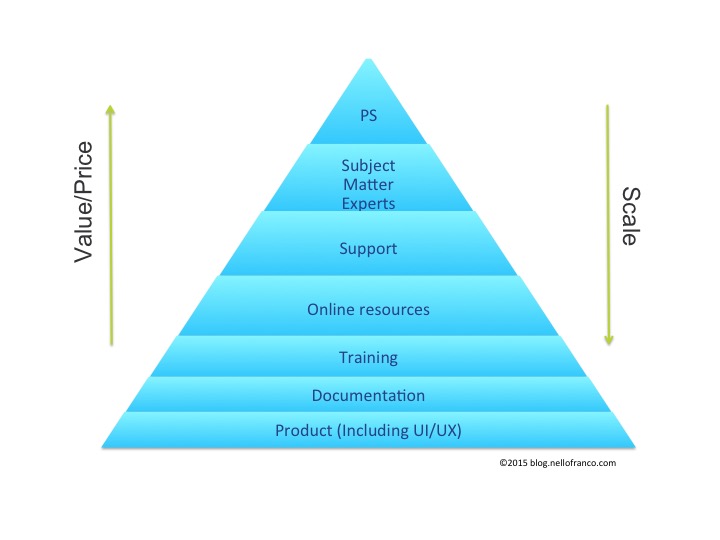I have been working in the training industry for over 20 years. People often talk about how the lack of training in the workplace affects employee performance, and employee engagement but inadequate training also affects customer adoption.
Wyzowl says that 8 in 10 users say they’ve deleted an app because they didn’t know how to use it and more than half (55%) of people say they’ve returned a product because they didn’t fully understand how to use it. Those are staggering drop-out rates…
Consequences of lack of training for employees
The consequences and costs of not providing training in the workplace can be widespread and significant, including decreased employee productivity, higher error rates, low employee morale and lack of compliance to legal and safety requirements. Companies who invest in employee training can gain the following benefits:
- Increased productivity and profitability: According to Gallup, companies are 17% more productive and 21% more profitable when they offer training to employees.
- Higher employee performance: According to SurveyMonkey, 59% of employees say training improves their overall job performance.
- Increased employee engagement: Accoding to Axonify, 92% of workers think workplace training positively impacts their job engagement.
- Increase job satisfaction: According to Rsearch.com, 39% of U.S. employees believe “potential for future growth” is the most important factor for job satisfaction.
- Increased employee pool: Gallup found that 59% of millennials say learning and growing are extremely important when applying for a job.
How training affects product adoption
Before subscriptions became popular, companies would sell perpetual licenses for one-time purchases of a product. In many cases the product would not be adopted and it would become shelfware. But companies didn’t really worry because they had made their money.
But with SaaS and other subscription-based sales models, where recurring revenue is a critical aspect of the company’s revenue profile and growth, keeping customers using and engaged with the product is critical to a company’s continued growth and success.
Training equips users with the knowledge and skills needed to use the product proficiently, makes them feel confident in their ability to use the product, and increases product adoption by introducing users to advanced features and use cases they might not discover on their own. It also reduces user frustration, which may result in resistance to the product.
Successful product adoption requires adequate training at just the right times in the customer’s journey so that they are getting the value they desire. Start by understanding your target audience, creating user personas, and understanding their specific needs, preferences, and pain points. Next define clear, measurable goals for adoption and track progress. Offer new training resources continuously to keep users engaged and help them become proficient. Think webinars, video tutorials, documentation, and live training sessions. Finally, create channels for users to provide feedback and suggestions so you can evolve your product adoption program.
How training affects customer onboarding
When I built and delivered training 10 years ago, a company’s onboarding, customer training and customer success strategy was to provide intense training soon after they purchased the product.
I travelled all over the world delivering “5-day intense customer onboarding sessions” to tens of employees. I would deliver so much information during these training sessions that it was like feeding them through a fire hose. At the end of these sessions, we expected customers to be fully proficient in how to use the product and use it to its fullest. Of course, we know now that this is not how people learn and how you increase user adoption.
Poor customer onboarding and training can have a significant negative impact on customers and the company in many ways. If users find it difficult to get started with your software or don’t see immediate value, they are more likely to cancel their subscription or churn. Appcues says that that the onboarding is the stage of the customer journey with the highest churn with 25% of users abandon apps after just one use and the biggest drop-off in usage happens during week 0 and week 1.
Once users have had a frustrating onboarding experience you are guaranteed that they are less likely to adopt the product. It also leads to an increase in time-to-value, a decrease in customer lifetime value (CLV), an increase in customer support costs, and fewer customer referrals.
A well-designed, user-friendly onboarding process should include comprehensive tutorials, documentation, continuous training and an introduction to customer support to ensure that users quickly understand and appreciate the value of your product.
One-time customer training = Strain on revenue
Aside from poor retention and user adoption, one of the downsides of the one-time onboarding sessions and lack of training and development is the strain on the rest of the organization. If a customer cannot remember what they have learnt or were not able to take the training session, they would either (a) not use the product or (b) call the sales reps or customer support team to get assistance.
I have seen these scenarios cause a lot of stress in an organization.
If the customer is not using the product or using the product to its fullest, you then have a sales rep who is in a panic at the end of the year who is trying to find ways “to save the customer”. Often, they will try and throw in some extra discounts to try and get the customer to renew again so that they perceive greater value when most of these same customers would have realized the value of the product had they fully adopted it and known how to get that value from it.
Not only does putting sales in the position where they have to “save the customer” increases the risk of losing the account, it also reduces opportunities to upsell and cross-sell, which can decrease Average Revenue Per User (ARPU), increase time-to-value, and reduce customer lifetime value.
One-time customer training = Strain on support teams
Beyond sales, I have seen immense strain on product support teams when organizations take train-once-and-hope-for-the-best approach. Clients will often turn to product support teams when they can’t find the information in the help, they can’t remember what they learnt during the initial onboarding session, or they weren’t present during the initial training.
As new customers purchase the product, you will see a huge spike in support tickets for issues that are not bugs or enhancements. Sometimes professional services people will have to step in again, schedule new engagements, fix thing that the customer may have “broken”. All this activity leads to additional stress on the organization.
Aside from unhappy support and professional services teams, you also risk having customers who don’t get deep into the product and don’t see the value in the product because they don’t understand how to do things. This can once again affect renewal rates.
Finally, customers want to be able to help themselves, Aspect found that 73% of customers want the ability to solve their product/service issues on their own. So why not help them self-serve?
New training models
Fortunately, customer training models have evolved to match this evolution to SaaS business models.
Now when I design training programs, I first help clients map out the customer journey. From there, we figure out what kind of training is needed. This will include the topics and modalities (online learning, instructor-led training, microlearning, blended learning etc.).
There is a curve to a customer’s learning path.
You initially want to onboard with some intensive training as they progress through the implementation of the new solution. Even at this stage I recommend that sessions are shorter and spread over time versus multi-day intensive sessions. This helps the learners fit the training into their regular schedule and allows you to provide them with the skills they need as they need them in the onboarding journey. After that you want to sprinkle in microlearning or webinars so that the customers continue to learn those nuggets that keep them engaged with the product and help them go deeper into it, making it even stickier.
You will also want to dedicate effort to building knowledge-base articles that allow clients to help themselves when they encounter issues or learn tips on how to do new things with your product.
A good example of why this approach works is to look at something that you use all the time. For me, it’s something like Microsoft Word. I’ve used Word for many years but still to this day, I find little nuggets of things that I didn’t know how to do within the tool that bring me extra value.
Great training leads to customer success
In my mind, product, training, adoption and customer success all build on each other. It’s like a pyramid. If you want great customer success, you need to have a great product, good documentation, great training, online resources and knowledgeable support and professional services teams. Have these in place and it will result in great customer adoption.
As you can see from the above customer success pyramid, product, documentation, training and online resources are the foundational pieces, are easy to scale and it is typically less costly to implement. Support, subject-matter experts and professional services (PS) can deliver more value but they are harder to scale and typically cost more. That is why I am such a firm believer in the value of training to deliver product adoption and success.
Speaking of money….
I often get asked about whether organizations should charge for training. Sales say, you should be giving training for free because it increases adoption and it’s a value-add. On the other hand, the C-suite might be asking whether they should be charging for training since it is an additional cost to the product and it delivers value to customers.
Here are my thoughts on this matter.
Each circumstance is unique. When asked whether clients should charge for training, I first like to understand the business itself, who their customers are, how much they are spending on a product and how much value the product can bring to an organization
I would expect to get free training with a cell phone. It’s a consumer product, I don’t expect to have one-on-one training for a consumer product. But in a business-to-business (B2B) context, I think the expectation is that you will pay for training for the product that you are purchasing.
There is some training and enablement that users should expect to get with their purchase. Whether that is included into the price of the purchase itself or it’s a line item, I believe that there should be a dollar value attached to training because it’s value that the customer is getting.
It is also value that they will only take seriously if clients see that they have paid for it. If you’ve received it for free, there’s a psychological aspect to that that indicates that it doesn’t have value. But it does.
Don’t stall your training program
Now that you see the importance of initially creating an effective training program it is also important to emphasize that you have to keep the program going. When you create one course, it’s like you’ve now created a baby and you’ve got to take care of the baby, and you’ve got to help it thrive.
Because most products evolve, the training programs should evolve with them.
You also need someone to manage your training programs and provide metrics to your customer success managers. This will allow them to answer questions like
- What’s this customer doing as far as training?
- Do they need more enablement?
- Do we need to poke them and say, “We notice that you haven’t been taking the training”?
All of these things combined are what brings value to a product.
Using technology to accelerate your training program
Aside from company commitment to training and knowledgeable resources, in my experience, technology is a big differentiator for helping training programs to keep pace. Think about how easy it became to deliver online training programs with the proliferation of Learning Management Systems (LMS)?
LEAi is another technology disruptor for the training industry.
My experience has been that people underestimate the time it takes to build the content for a training course, especially those organizations that use the traditional process where learning and development staff are interviewing subject matter experts (SMEs) and then translating their knowledge into course content using word processing tools (like Word or PowerPoint). This is a long and manual process that requires time and expertise.
We created LEAi to increase the speed and success of course creation.
The nice thing about LEAi is that it imports the raw information from your SMEs and the output is well structured training that follows industry best practices. Not only does LEAi help create the training content for you, it also creates your learning objectives, course description and test questions. And even beyond that, you can also use the tool to repurpose content and build microlearning.
This translates to significant delivery of new courses which leads to less stress in an organization. Who couldn’t use less stress? If you would like to get a demo of our LEAi or discuss how to structure your training programs so you can accelerate delivery speed, give a shout.





